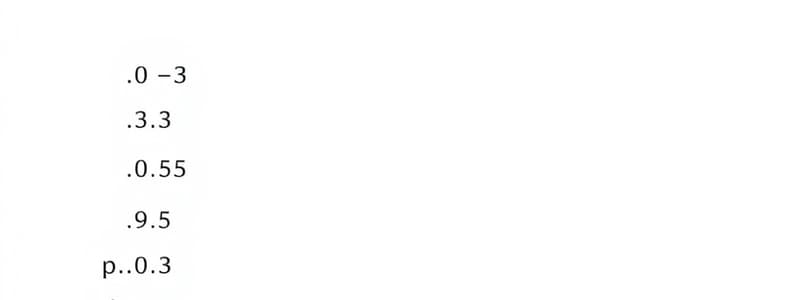Podcast
Questions and Answers
In a simulation of a test distribution, what does the standard deviation of the point estimates indicate?
In a simulation of a test distribution, what does the standard deviation of the point estimates indicate?
- The average of the point estimates across all simulations.
- The number of simulations performed.
- The typical deviation of individual point estimates from the average point estimate. (correct)
- The range of the point estimates observed in the simulations.
What does a simulation of a test distribution with 10,000 rounds primarily help to understand?
What does a simulation of a test distribution with 10,000 rounds primarily help to understand?
- The exact value of the point estimate in the original sample.
- The variability and range of possible point estimates due to random sampling. (correct)
- The computational cost of statistical analysis.
- The sources of bias in the original sample data.
Given that a simulation yields a point estimate average of -0.099 and a standard deviation of 4.03, which of the following statements is most accurate?
Given that a simulation yields a point estimate average of -0.099 and a standard deviation of 4.03, which of the following statements is most accurate?
- The simulation is flawed because the average point estimate is negative.
- Individual point estimates from random splits typically deviate from -0.099 by about 4.03. (correct)
- All random splits will produce point estimates close to -0.099.
- The true population parameter is exactly -0.099.
If a simulation of a test distribution shows that the largest difference observed is 14.97, what does this imply about the point estimate?
If a simulation of a test distribution shows that the largest difference observed is 14.97, what does this imply about the point estimate?
In the context of simulating test distributions, what is the purpose of performing 'random splits' of the sample?
In the context of simulating test distributions, what is the purpose of performing 'random splits' of the sample?
What does the p-value represent in the context of hypothesis testing?
What does the p-value represent in the context of hypothesis testing?
In a simulation designed to test a null hypothesis of zero treatment effect, what does a point estimate represent?
In a simulation designed to test a null hypothesis of zero treatment effect, what does a point estimate represent?
If a simulation shows that a difference greater than the point estimate occurs in 1.1% of the simulation rounds, what does this suggest about the statistical significance of the point estimate?
If a simulation shows that a difference greater than the point estimate occurs in 1.1% of the simulation rounds, what does this suggest about the statistical significance of the point estimate?
What is the correct interpretation of $H_0 : E[y | D = 1] = E[y | D = 0]$ in the context of a treatment effect?
What is the correct interpretation of $H_0 : E[y | D = 1] = E[y | D = 0]$ in the context of a treatment effect?
In the context of the provided information, what is the purpose of simulating a test distribution?
In the context of the provided information, what is the purpose of simulating a test distribution?
A researcher obtains a point estimate of -0.09 and, after 10,000 simulation rounds, finds the standard deviation to be 4.03. What does this standard deviation indicate?
A researcher obtains a point estimate of -0.09 and, after 10,000 simulation rounds, finds the standard deviation to be 4.03. What does this standard deviation indicate?
A study yields a point estimate. After conducting a simulation to assess statistical significance, the researcher finds that a more extreme difference than the point estimate occurs in 7% of simulation rounds. How should the researcher interpret this result?
A study yields a point estimate. After conducting a simulation to assess statistical significance, the researcher finds that a more extreme difference than the point estimate occurs in 7% of simulation rounds. How should the researcher interpret this result?
What is the main implication of the Central Limit Theorem in the context of statistical testing?
What is the main implication of the Central Limit Theorem in the context of statistical testing?
Why might approximating the test distribution using the Central Limit Theorem be advantageous?
Why might approximating the test distribution using the Central Limit Theorem be advantageous?
According to the Central Limit Theorem, which of the following conditions must be met for the sampling distribution of the sample mean to be approximately Normal?
According to the Central Limit Theorem, which of the following conditions must be met for the sampling distribution of the sample mean to be approximately Normal?
If a test distribution is observed to resemble a Normal distribution, what statistical principle is likely at play?
If a test distribution is observed to resemble a Normal distribution, what statistical principle is likely at play?
Imagine you are analyzing the mean height of a large, random sample of adults from a city. Even if the distribution of heights in the city is not normal, what does the Central Limit Theorem allow you to assume about the sampling distribution of the sample mean?
Imagine you are analyzing the mean height of a large, random sample of adults from a city. Even if the distribution of heights in the city is not normal, what does the Central Limit Theorem allow you to assume about the sampling distribution of the sample mean?
A researcher wants to estimate the average income of people in a country. They collect a large, random sample and calculate the sample mean. How does the Central Limit Theorem assist in making inferences about the population mean?
A researcher wants to estimate the average income of people in a country. They collect a large, random sample and calculate the sample mean. How does the Central Limit Theorem assist in making inferences about the population mean?
In what scenario would approximating a test distribution using the Central Limit Theorem be most beneficial?
In what scenario would approximating a test distribution using the Central Limit Theorem be most beneficial?
Suppose a statistician is analyzing a dataset with a non-normal distribution. What is the Central Limit Theorem useful for?
Suppose a statistician is analyzing a dataset with a non-normal distribution. What is the Central Limit Theorem useful for?
A data scientist is tasked with testing a hypothesis about the population mean. It is too computationally expensive to use a simulated test distribution. How can they use the central limit theorem to approximate?
A data scientist is tasked with testing a hypothesis about the population mean. It is too computationally expensive to use a simulated test distribution. How can they use the central limit theorem to approximate?
What does a graphical representation of a confidence interval typically include?
What does a graphical representation of a confidence interval typically include?
Why is the interpretation of confidence intervals considered a subtle subject?
Why is the interpretation of confidence intervals considered a subtle subject?
What is the primary advantage of presenting results with confidence intervals?
What is the primary advantage of presenting results with confidence intervals?
Suppose a study reports a 95% confidence interval for a population mean as (10, 20). Which of the following statements is the MOST accurate interpretation?
Suppose a study reports a 95% confidence interval for a population mean as (10, 20). Which of the following statements is the MOST accurate interpretation?
A researcher calculates a 90% confidence interval for the difference in means between two groups and finds the interval to be (-2.5, 1.0). What can be concluded from this result?
A researcher calculates a 90% confidence interval for the difference in means between two groups and finds the interval to be (-2.5, 1.0). What can be concluded from this result?
How does increasing the confidence level (e.g., from 95% to 99%) typically affect the width of a confidence interval, assuming all other factors remain constant?
How does increasing the confidence level (e.g., from 95% to 99%) typically affect the width of a confidence interval, assuming all other factors remain constant?
In hypothesis testing, how does the width of a confidence interval relate to the p-value?
In hypothesis testing, how does the width of a confidence interval relate to the p-value?
A research team is studying the effectiveness of a new drug. They calculate a 95% confidence interval for the mean difference in blood pressure between the treatment and control groups as (2 mmHg, 8 mmHg). What is the MOST reasonable conclusion?
A research team is studying the effectiveness of a new drug. They calculate a 95% confidence interval for the mean difference in blood pressure between the treatment and control groups as (2 mmHg, 8 mmHg). What is the MOST reasonable conclusion?
A confidence interval is constructed for a population proportion. Which of the following changes would generally lead to a NARROWER confidence interval, assuming all other factors remain constant?
A confidence interval is constructed for a population proportion. Which of the following changes would generally lead to a NARROWER confidence interval, assuming all other factors remain constant?
Flashcards
Point Estimate
Point Estimate
Estimates a population parameter based on sample data.
Average of Point Estimates
Average of Point Estimates
The average value of a statistic calculated over many simulations.
Standard Deviation of Point Estimates
Standard Deviation of Point Estimates
Measures the spread or variability of point estimates in a simulation.
Simulating a Test Distribution
Simulating a Test Distribution
Signup and view all the flashcards
Random Splits of the Sample
Random Splits of the Sample
Signup and view all the flashcards
Standard Deviation (Simulation)
Standard Deviation (Simulation)
Signup and view all the flashcards
Sample Variation
Sample Variation
Signup and view all the flashcards
P-value
P-value
Signup and view all the flashcards
Null Hypothesis
Null Hypothesis
Signup and view all the flashcards
Null Hypothesis (Treatment)
Null Hypothesis (Treatment)
Signup and view all the flashcards
E[y | D = 1] = E[y | D = 0]
E[y | D = 1] = E[y | D = 0]
Signup and view all the flashcards
Simulated Test Distribution
Simulated Test Distribution
Signup and view all the flashcards
Central Limit Theorem
Central Limit Theorem
Signup and view all the flashcards
Sampling Distribution
Sampling Distribution
Signup and view all the flashcards
Approximate Test Distribution
Approximate Test Distribution
Signup and view all the flashcards
Simulated Test Distribution
Simulated Test Distribution
Signup and view all the flashcards
Simulated Test Distribution
Simulated Test Distribution
Signup and view all the flashcards
Sampling Distribution
Sampling Distribution
Signup and view all the flashcards
Central Limit Theorem
Central Limit Theorem
Signup and view all the flashcards
Confidence Interval (CI)
Confidence Interval (CI)
Signup and view all the flashcards
Confidence Interval Construction
Confidence Interval Construction
Signup and view all the flashcards
Graphical Representation of CIs
Graphical Representation of CIs
Signup and view all the flashcards
Informative Results by CI
Informative Results by CI
Signup and view all the flashcards
Effective data presentation using CIs
Effective data presentation using CIs
Signup and view all the flashcards
Compact presentation with CI
Compact presentation with CI
Signup and view all the flashcards
Subtlety of Confidence Intervals
Subtlety of Confidence Intervals
Signup and view all the flashcards
Sampling Distribution to create CI
Sampling Distribution to create CI
Signup and view all the flashcards
Study Notes
- Causality involves understanding how one thing influences another.
- Requires comparing counterfactual states ("how would Y change if we changed X?")
- Only one state is observed.
- Key elements in a causal research question:
- Outcome
- Treatment
- Counterfactual
- Population
- A control group in experimental design helps infer what would have happened to the treatment group without the treatment.
- Selection bias occurs when control group is not comparable to the treatment group, leading to potential outcome differences.
- E[y0|D = 0] ≠ E[y0|D = 1]
- Randomization eliminates selection bias, so the only difference between groups is treatment.
- Differences in outcomes are due to the treatment.
Hypothesis Testing and Statistical Significance
- Key question: How likely is the difference between treatment and control groups due to chance?
- Test the null hypothesis that the treatment had no effect.
- Learning Objectives focus on understanding the following concepts:
- Point estimates
- Standard errors
- p-values
- statistical significance
- t-statistics
- critical values
- confidence intervals
- false positives and negatives (Type I and II errors)
- Use them for basic empirical results.
- Chattopadhyay and Duflo's 2004 study examined India's 1993 reform and policy outcomes.
- Leaders invest more in infrastructure directly relevant to their own genders (e.g., women investing in drinking water).
- Data: 161 village councils ("Gram Panchayats" or GPs), 54 reserved for women leaders.
Point Estimate
- Average[y | D = 1] = 23.8
- Average[y | D = 0] = 14.7
- D = 1 denotes that GPs are reserved for female leader
- ӯ¹ – ӯº = P is the point estimate
- P more drinking facilities are built per village when a GP is led by a woman
- If GPs were randomly assigned into treatment and control groups, selection bias is deemed unlikely.
- Point estimates may differ from zero.
- Female leaders are more likely to invest in drinking water.
- 54 treatment GPs may invest more in drinking water for reasons unrelated to the gender of leader.
- The convention calls an estimate statistically significant if the likelihood of a chance finding is below 5%.
Simulating a Test Distribution
- An intuitive way to think about it is creating a distribution of "placebo" treatments.
- Procedure: split GPs randomly into "treatment" and "control" groups and then calculate averages.
- "placebo" assignments Dpl are made-up. Therefore, there is no impact.
P-Value
- P-value represents the probability of obtaining a result at least as extreme as the result actually observed under the null hypothesis.
- Here, the null hypothesis is zero treatment effect, i.e. Ho : E[y|D = 1] = E[y|D = 0].
- "2-sided” test: determines the likelihood of such a large deviation in absolute value from zero by chance.
- Estimates are called "statistically significant"(reject null hypothesis) if the p-value is less than 5%.
Central Limit Theorem
- The central limit theorem: The sampling distribution of the sample mean of a large number of independent random variables is approximately Normal
Standard Errors
- Standard error is the standard deviation of a statistic.
- The statistic of interest here is the treatment effect estimate (difference between treatment and control group means).
- Variability in the treatment effect estimate is due to the random sampling randomness in treatment/control assignment.
Standard Errors: Calculation
- You can estimate the standard error for the difference in averages between two groups this way:
- ŜE(ӯ¹ – ӯº) = S(yi) √ 1/ n₁ + 1/n₀
- S(yi) is a sample standard deviation of y.
- n₁ and n₀ are the number of observations in the treatment and control groups.
- Alternative estimators for SEs exist, which each corresponds to different assumptions.
- Experiments yield more precise evidence when the outcome variable has less variation and the experiment is larger (higher n₁ and/or n₀)
- Earlier example: corresponding numbers are
- ŜE(ӯ¹ – ӯº) = S(yi) √ 1/n₁ + 1/n₀ = 18.4 * √ 1/54 + 1/107 = 4.02*.
- This is a close approximation for the standard deviation of the simulated test distribution.*
T-Statistic
- To denote, one must state the statistic of interest with к. One must also define the value using the null hypothesis using μ. Then the t-statistic:
- t(μ) = (K – μ)/SE(K).
- For treatment efforts, the hypothesis assumes = 0. Under that, the t-value using the average treatment effect is as following:
- t(0) = (K- μ)/SE(K)
- 1 – 0/ SE(1 - 0)
- the t-value is distributed, approximately, t to roughly N(0, 1), also referred to standard normal distribution
- The probability of drawing 2.26 or more from a standard Normal Distribution has a 1.19% chance of occuring
- It is more appropriate when the sample distribution is to calculate p-values
- 2 sided p-value is 0.0238
Critical Values
- A point in the test distribution has a corresponding p-value
- in large samples, a t-statistic of 1.96 corresponds to a p-value of 0.05 in a 2 sided test.
- A common rule-of-thumb is to call a result "statistically significant" if the point estimate is at least twice as large as its standard error
Condfidence Intervals
- The relevant question is how large/small efforts can be ruled out
- we can use confident intervals and 95% confidence intervals at that.
- [ẞ – 1.96 × SE, ẞ + 1.96 × SE].
- 96 corresponds to a p-value of 0.05 in a 2-sided test where the statistic (e.g. average treatment effect) is distributed
- In an example, we had. If there's 9.1 then Se is 4.02. Therefore the answer is simply to find what the Cl is 95%
- Cls are graphically prevented/often presented.
Misunderstandings
- Often times there is severe misunderstanding between "statistically significant" and the opposite to happen
- treatment is incorrectly thought to have been "proven to be effective" when ***< .05 or "proven to have no effect" when **> .05.
- One simply must understand and interpret lots of research where statistical significance is used so one must abandon the whole concept
Testing Errors
- False Positives: Saying that there is an error when it does not exist
- Also referred to as a Type 1
- False Negative: Not finding an error when a result does not exist.
- Aka called "Type 2" Error.
- Power: The probability of finding when it occurs.
- Statistical Significance: Its purpose is to avoid false positives
Studying That Suits You
Use AI to generate personalized quizzes and flashcards to suit your learning preferences.




